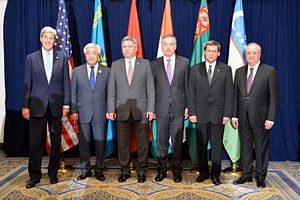U.S. Secretary of State John Kerry is set to be the latest high-profile visitor making the rounds in Central Asia later this week. Kerry will touch down in Bishkek on Thursday, after a stop Wednesday in Vienna for talks on the ongoing Syrian crisis. Visits to Samarkand, Astana, Dushanbe, and Ashgabat fill out the remainder of the trip, ending on November 3.
Kerry will be the first U.S. secretary of state to visit all five Central Asian republics in one trip. He is not, however, the region’s first high-profile visitor this year. Central Asia, a region often neglected in international media, has nonetheless been the focus of a series of global diplomatic overtures. In June, UN Secretary-General Ban Ki-moon traveled to all five former Soviet republics. In July, Indian Prime Minister Narendra Modi made the trip and Japanese Prime Minister Shinzo Abe just concluded his grand tour of the region. Last year, South Korean President Park Geun-hye visited Kazakhstan, Uzbekistan and Turkmenistan.
Chinese President Xi Jinping has made multiple trips to the region over the years, usually scheduled to coincide with the annual Shanghai Cooperation Organization (SCO) heads of state summit. China, along with Russia, Kazakhstan, Kyrgyzstan, Uzbekistan and Tajikistan, is part of the SCO, which rotates it summits among the members. In 2013, Xi visited Kyrgyzstan–the summit host–as well as Kazakhstan, Uzbekistan and Turkmenistan. The following year, Xi visited Tajikistan.
Russian President Vladimir Putin is a frequent traveler to much of the region as well and often hosts Central Asia’s leaders in Russia (sometimes the day before his birthday). Proximity and history have their diplomatic benefits. Putin and Kazakh President Nursultan Nazarbayev have met no less than 13 times this year–in Moscow, Astana, and elsewhere in the world–brought together by various international groupings to which the two belong.
According to the U.S. State Department, Kerry’s itinerary includes opening the American University of Central Asia’s new campus in Bishkek as well as dedicating a new building at the embassy there.
In Uzbekistan, Kerry will skip the capital in favor of the ancient city of Samarkand where the region’s foreign ministers will gather for what the U.S. Department of State categorizes as a “new format for dialogue.” They’re calling it the C5+1. The new format was forecast in September when Kerry and the five Central Asian foreign ministers met on the sidelines of the UN General Assembly. Ostensibly, the group will discuss region-wide concerns and though no details are yet available, it’s safe to assume terrorism and border security will be mentioned.
In Kazakhstan, Kerry will participate in the 4th U.S.-Kazakhstan Strategic Partnership Dialogue in addition to delivering a speech at Nazarbayev University “on Central Asia’s role in addressing global issues.” Astana seems to be the place for big speeches in the region: Modi gave a memorable address at Nazarbayev University and, though less memorable in substance, Abe gave a lecture at the university as well.
Details on Kerry’s stops in Turkmenistan and Tajikistan are thin. State says “the Secretary will discuss a range of bilateral and regional issues of mutual interest with senior government officials.”
There will be considerable pressure from human rights groups for Kerry to bring up abuses across the region–whether it is the crackdown on independent media in Kazakhstan and Turkmenistan, the decimation of political opposition in Tajikistan, or torture in Uzbekistan. Japan’s Abe was similarly prodded to discuss human rights in the region, though there is no evidence he did so in a meaningful way.
Discussions around security, energy, and economics are likely to be the core of Kerry’s diplomatic efforts in Central Asia. But it is not without precedent for Kerry, behind closed doors, to lobby for the release of political prisoners. While this tactic works in individual cases, it has not yielded a marked improvement in the region’s human rights record.

































